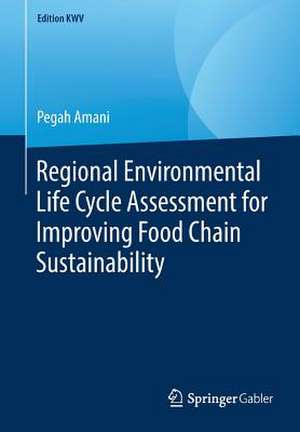Regional Environmental Life Cycle Assessment for Improving Food Chain Sustainability: Edition KWV
Autor Pegah Amanien Limba Engleză Paperback – 12 feb 2019
Current LCA methodologies employed to assess the intensity of environmental impacts lack a regional view, even though the sensitivity of the receiving environment is important in determining the specific levels of risks.
This book seeks to redress the balance and develop a globally applicable, affordable and feasible approach to determine differentiated sets of possible impacts with higher environmental burdens derived from food supply chain processes. To this end, the earth’s land surface is divided into so-called “ecoregions”, defined by their specific characteristics such as soil, climate, and topography/physiography, and associated with the relevant risks for each ecoregion.
The use of ecoregions and respective environmental risks can help enterprises recognize the environmental effect of their products but also help improve the reliability of comparisons between LCA results in different regions.
Din seria Edition KWV
-
 Preț: 326.38 lei
Preț: 326.38 lei -
 Preț: 192.87 lei
Preț: 192.87 lei -
 Preț: 217.90 lei
Preț: 217.90 lei -
 Preț: 457.80 lei
Preț: 457.80 lei -
 Preț: 364.56 lei
Preț: 364.56 lei -
 Preț: 317.68 lei
Preț: 317.68 lei -
 Preț: 461.50 lei
Preț: 461.50 lei -
 Preț: 390.63 lei
Preț: 390.63 lei -
 Preț: 279.06 lei
Preț: 279.06 lei -
 Preț: 291.74 lei
Preț: 291.74 lei -
 Preț: 298.65 lei
Preț: 298.65 lei -
 Preț: 318.44 lei
Preț: 318.44 lei -
 Preț: 461.50 lei
Preț: 461.50 lei -
 Preț: 213.20 lei
Preț: 213.20 lei -
 Preț: 459.00 lei
Preț: 459.00 lei -
 Preț: 214.74 lei
Preț: 214.74 lei -
 Preț: 454.92 lei
Preț: 454.92 lei -
 Preț: 277.48 lei
Preț: 277.48 lei -
 Preț: 218.42 lei
Preț: 218.42 lei -
 Preț: 349.74 lei
Preț: 349.74 lei -
 Preț: 248.75 lei
Preț: 248.75 lei -
 Preț: 382.36 lei
Preț: 382.36 lei -
 Preț: 264.79 lei
Preț: 264.79 lei -
 Preț: 393.13 lei
Preț: 393.13 lei -
 Preț: 232.74 lei
Preț: 232.74 lei -
 Preț: 140.26 lei
Preț: 140.26 lei -
 Preț: 319.43 lei
Preț: 319.43 lei -
 Preț: 501.99 lei
Preț: 501.99 lei -
 Preț: 294.04 lei
Preț: 294.04 lei -
 Preț: 350.30 lei
Preț: 350.30 lei -
 Preț: 388.72 lei
Preț: 388.72 lei -
 Preț: 271.16 lei
Preț: 271.16 lei -
 Preț: 138.74 lei
Preț: 138.74 lei -
 Preț: 285.38 lei
Preț: 285.38 lei -
 Preț: 349.74 lei
Preț: 349.74 lei -
 Preț: 380.84 lei
Preț: 380.84 lei -
 Preț: 425.96 lei
Preț: 425.96 lei -
 Preț: 460.69 lei
Preț: 460.69 lei -
 Preț: 392.21 lei
Preț: 392.21 lei -
 Preț: 381.98 lei
Preț: 381.98 lei -
 Preț: 279.98 lei
Preț: 279.98 lei -
 Preț: 221.48 lei
Preț: 221.48 lei -
 Preț: 292.72 lei
Preț: 292.72 lei -
 Preț: 273.83 lei
Preț: 273.83 lei -
 Preț: 432.71 lei
Preț: 432.71 lei -
 Preț: 354.17 lei
Preț: 354.17 lei -
 Preț: 238.35 lei
Preț: 238.35 lei -
 Preț: 275.47 lei
Preț: 275.47 lei -
 Preț: 288.87 lei
Preț: 288.87 lei
Preț: 322.49 lei
Nou
Puncte Express: 484
Preț estimativ în valută:
61.72€ • 67.01$ • 51.84£
61.72€ • 67.01$ • 51.84£
Carte tipărită la comandă
Livrare economică 22 aprilie-06 mai
Preluare comenzi: 021 569.72.76
Specificații
ISBN-13: 9783658240080
ISBN-10: 3658240083
Pagini: 243
Ilustrații: XXVI, 243 p. 1 illus.
Dimensiuni: 168 x 240 mm
Greutate: 0.44 kg
Ediția:1st ed. 2012, reprint 2019
Editura: Springer Fachmedien Wiesbaden
Colecția Springer Gabler
Seria Edition KWV
Locul publicării:Wiesbaden, Germany
ISBN-10: 3658240083
Pagini: 243
Ilustrații: XXVI, 243 p. 1 illus.
Dimensiuni: 168 x 240 mm
Greutate: 0.44 kg
Ediția:1st ed. 2012, reprint 2019
Editura: Springer Fachmedien Wiesbaden
Colecția Springer Gabler
Seria Edition KWV
Locul publicării:Wiesbaden, Germany
Cuprins
1 Introduction.- 2 Environmental impact assessment in a food network.- 3 Ecosystem and food network.- 4 Geographical division of global lands into “ecoregions”.- 5 Analysis of environmental risks associated with ecoregions.- 6 Selection of relevant impact categories and LCIA methodologies for the environmental assessment of food products.- 7 Discussion and recommendations.- Bibliography.- Appendices.- A Data collection.- B Detailed analysis of the environmental risks associated with ecoregions.
Notă biografică
Pegah Amani published her work with Kölner Wissenschaftsverlag until 2018.
Textul de pe ultima copertă
Current LCA methodologies employed to assess the intensity of environmental impacts lack a regional view, even though the sensitivity of the receiving environment is important in determining the specific levels of risks.
This book seeks to redress the balance and develop a globally applicable, affordable and feasible approach to determine differentiated sets of possible impacts with higher environmental burdens derived from food supply chain processes. To this end, the earth’s land surface is divided into so-called “ecoregions”, defined by their specific characteristics such as soil, climate, and topography/physiography, and associated with the relevant risks for each ecoregion.
The use of ecoregions and respective environmental risks can help enterprises recognize the environmental effect of their products but also help improve the reliability of comparisons between LCA results in different regions.
Caracteristici
Gives an insight into environmental burdens derived from food supply chain processes Develops an globally applicable approach to determine differentiated sets of possible impacts with higher environmental burdens Defines specific characteristics for so-called “ecoregions”
